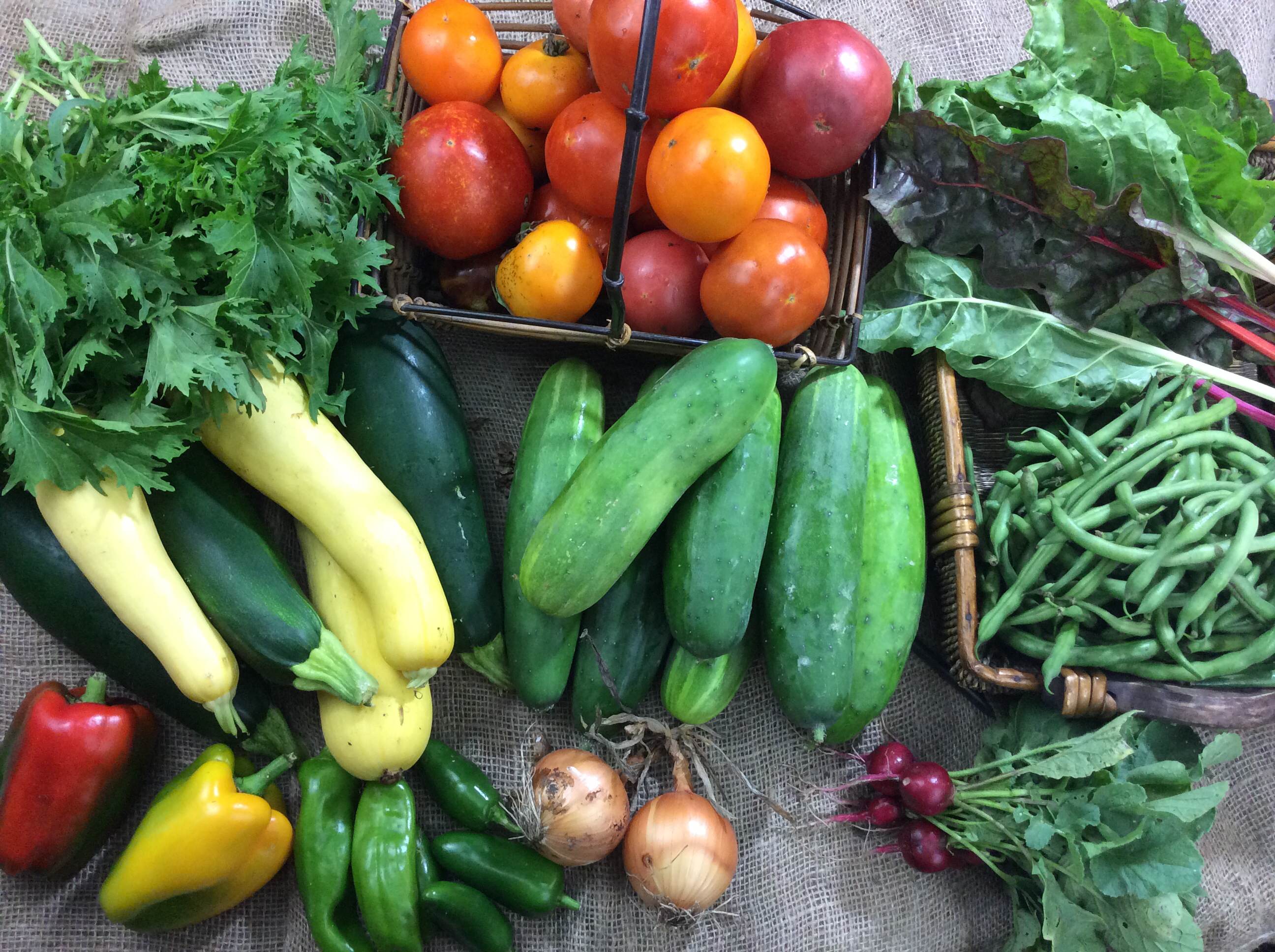Week 16 of the Redfearn farm CSA includes lots of great summer vegetables; we are continuing to harvest lots of tomatoes, zucchini and cucumbers and the next couple weeks we will have lots of green beans! Pictured, beginning at top left: Mizuna (Choice of Mizuna or Mustard Greens), Tomatoes, Swiss Chard (Full shares only), Green beans, Radishes with tops, Cucumbers, Candy Onions, Hot peppers, Sweet peppers, and Zucchini/ yellow squash.
Mizuna (asian mustard green): store in plastic bag in fridge. These greens are stronger in flavor than spinach or chard and are a little spicy. I would NOT recommend adding mustard greens to smoothies. Mizuna can be eaten raw in salad or more often is cooked. Basic cooking instructions: Cut off the root end of the greens, wash and dry well (a salad spinner works great) and chop well. Heat oil (butter or bacon grease) in a sauté pan over medium heat, add chopped onion if desired, cook onion till it begins to color, add chopped greens a little at a time and cook until tender (some people like to add a little water or chicken broth to help the greens cook), season with salt and pepper to taste. Indian Saag can be made using a mixture of chopped greens (like mustard or turnip greens with spinach or chard). Here is general instructions for Braising Dark Green Leafy Vegetables or this Sauteed Mizuna with Garlic and Fish Sauce.
Mustard greens: store in plastic bag in fridge. These greens are stronger in flavor than spinach or chard and are spicy. I would NOT recommend adding mustard greens to smoothies. This week’s mustard greens are quite young, so you don’t need to boil them first, and the stem is thin enough to be included in recipes. Basic cooking instructions: Cut off the root end of the greens, wash and dry well (a salad spinner works great) and chop well. Heat oil (butter or bacon grease) in a sauté pan over medium heat, add chopped onion if desired, cook onion till it begins to color, add chopped greens a little at a time and cook until tender (some people like to add a little water or chicken broth to help the greens cook), season with salt and pepper to taste. Indian Saag can be made using a mixture of chopped greens (like mustard or turnip greens with spinach or chard).
One of our favorite recipes for mustard greens is this Curried Mustard Greens with Kidney Beans. I don’t usually boil the greens first; instead sauté them in some oil at the beginning of the directions.
Tomatoes: Store at cool room temperature, in a single layer if possible, not in a plastic bag. Here is a website that gives many different Tomato Salad Ideas. This Roasted Tomato Tart recipe is a favorite of mine. Another favorite is baking thick slices with a cheese topping like these Parmesan Tomatoes (I made them without the spicy brown mustard, and really liked them).
To preserve tomatoes: you can freeze them by cutting out the core and any bad spots and putting them in a freezer bag. To use after freezing: thaw slightly in water and the tomato skin can be easily peeled off. The tomatoes can them be used in soup, sauces or other cooked tomato recipes (after freezing the tomatoes will be very soft, but still have good flavor). You can also dry (sliced) tomatoes in a dehydrator following your dehydrators instructions. Or roast tomatoes until desired dryness and then freeze. Tomatoes can also be canned whole, chopped, as salsas or tomato/ pasta sauce (make sure to follow a recipe that is designed for home canning!).
Here are a few more tomato ideas:
Swiss Chard: store in plastic bag in fridge. Both the stem and the leaves can be eaten and I usually use both together; chop the stems like you would celery and begin cooking the stems before adding the greens. Our family really likes this Swiss Chard, Sausage, White bean casserole (which also uses a little fennel bulb, and I use the stems and leaves of the chard). This Swiss Chard and Ricotta Crostata is a wonderful recipe, and one of my all-time favorites.
Green beans: store in plastic bag in refrigerator. Basic cooking instructions: trim the stem end off and leave beans whole or snap into shorter pieces. Heat a pot of salted water to boiling, add beans, and boil 2 to 3 minutes, until almost tender- crisp. Drain beans very well (if you will be finishing the beans later, cool the bean beans to prevent further cooking). Heat butter and olive oil in a skillet (about 1 T each, can be increased or decreased to taste) over medium heat, add beans and salt and pepper to taste, and stir until tender, toward the end of cooking add 1 or 2 cloves garlic (chopped) if desired. Additions: crumbled bacon, toasted slivered almonds, stirred into the beans after cooking.
Radishes: a new crop of radishes is ready for harvest! The roots and greens are both very good to eat. Store in plastic bag in refrigerator, the roots separate from the greens. Crisp radishes in ice water. You can just eat them straight with butter and a sprinkle of salt. There are many variations of radish salads, here are a couple: Radish and Mint Salad (I have made variations of this dish and really like it) Smitten Kitchen’s chopped salad
Here’s a recipe utilizing both the radish roots and tops: Radish and Radish Top Soup
Cucumbers: store in a plastic big in fridge. Smaller cucumbers have tender skin and small seeds, larger cucumbers have thicker skin and larger seeds. Larger cucumbers can be cut lengthwise to scoop out the seeds. For cucumber salads or to make cucumber sauce (tzatziki sauce), I peel cucumbers, slice lengthwise, scoop out seeds, slice or chop (depending on recipe), lightly salt the cucumber pieces, and let drain 15 to 20 minutes, and sometime even pat dry. Salting and draining the cucumbers removes a lot of their water and allows them to absorb more “dressing”. Here are a couple cucumber salad ideas: Cucumbers with Sour Cream, Cucumber and Tomato Salad. Smaller cucumbers make great pickles, like this Dill Pickle recipe. Also try cucumber soup; such as this cream of cucumber soup or cold cucumber soup.
Swiss Chard: store in plastic bag in fridge. Both the stem and the leaves can be eaten and I usually use both together; chop the stems like you would celery and begin cooking the stems before adding the greens. Our family really likes this Swiss Chard, Sausage, White bean casserole (which also uses a little fennel bulb, and I use the stems and leaves of the chard). This Swiss Chard and Ricotta Crostata is a wonderful recipe, and one of my all-time favorites.
Hot peppers: Store in plastic bag, in refrigerator. Chop and add to salsa, or use in this Jalapeno Popper Chicken.
Sweet pepper: Store in plastic bag, in refrigerator. Meal idea: sauté sliced candy onions and sweet pepper for a tasty Philly Cheese Sandwich . This has become a family favorite!
Zucchini/ summer squash: store in plastic bag in refrigerator. Zucchini is great sauteed, grilled, eaten raw, or baked into zucchini bread (my kids favorite way to eat zucchini!). Zucchini (sliced and broiled or pan fried) can take the place of pasta in lasagna. If you want more ideas, you can try Baked Zucchini Fries, Squash baked eggs or Zucchini Fritters (these were very good) or Chocolate Zucchini Bread. One of our favorite recipe for a main dish of zucchini is this Cheesy Zucchini Casserole (which we make with shredded sharp cheddar, instead of Velvetta; chopped sweet peppers and sliced fennel can be added to the onion while sautéing ). Here’s a couple other zucchini recipes, recommended by CSA members: Curried Zucchini Soup, Sauteed Zucchini with Cherry Tomatoes (don’t overcook the zucchini!), and Zucchini Chocolate Rum Cake.
To preserve zucchini/ yellow squash: option 1: shred and freeze in freezer bags, to use in zucchini bread or soups or sauces. Option 2: dehydrate in dehydrator until dry like a chip. I usually store in the freezer, if not perfectly dry. Use the dried zucchini in winter soups or sauces (make sure to add them early enough for them to rehydrate).
Zucchini or Summer Squash Lasagna
6-8 small- medium Summer Squash (yellow, green or combination)
1 lb. Ground Beef or Sausage
1 medium Onion, chopped
3-4 cloves Garlic, chopped
1 (24 oz) jar Pasta Sauce (homemade or store- bought)
15 oz. Ricotta Cheese
1/2 C. grated Parmesan Cheese
8 oz. shredded Mozzarella Cheese
2 Eggs
¼- ½ C. fresh basil, chopped
Directions:
- Slice squash lengthwise into ¼ inch slices, sprinkle with salt and let stand 30 minutes. Drain and pat dry. Lightly brown slices, both sides, in olive oil in large skillet or griddle. Roasting the squash slices at 400 F is another method. Set aside.
- Meanwhile, brown meat with chopped onion and drain. Return to pan and add chopped garlic, cook 1 minute and add pasta sauce, half of chopped basil and salt and pepper to taste. Set meat sauce aside.
- In a mixing bowl, combine ricotta cheese, half of grated parmesan, half of shredded mozzarella, 2 eggs, remaining chopped basil, and freshly ground pepper.
- In a 9” x 13” pan, spread a small amount of meat sauce in the bottom. Layer with 1/3 of the squash slices, top with half the cheese mixture and 1/3 of the meat sauce; repeat once. Top with the remaining squash and meat sauce. Reserve remaining shredded mozzarella and Parmesan for topping.
- Cover and bake at 375 F for 20-30 minutes or until bubbly. Top with remaining cheeses and bake 5 more minutes.

